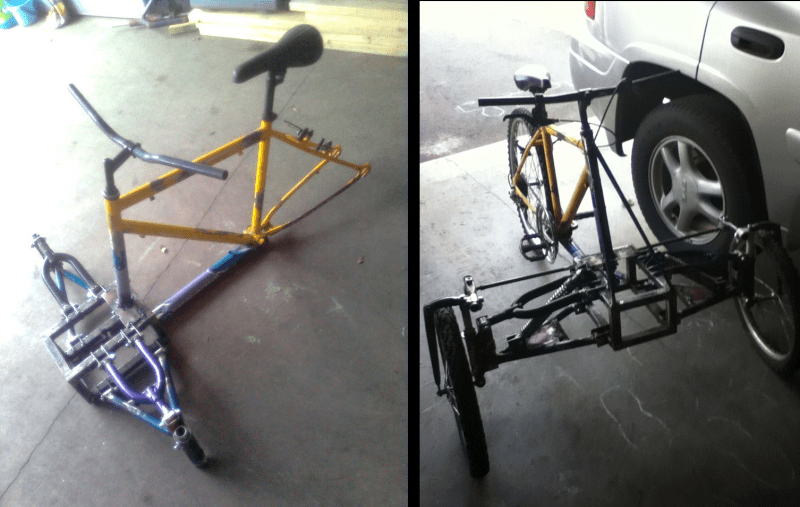There is certainly no shortage of bicycle builds out there on the ‘net. We’re not talking custom race bikes or anything here, we mean cool odd-ball bikes built just because. We’ve seen trike conversions before, both with single wheels in the front and in the back, but today we stumbled across something we haven’t seen before.
[Kong79] has built a reverse trike, with 2 wheels in the front. That by itself is nothing new but this trike has an independent front suspension, meaning each wheel can move up and down independently from the other. This particular build uses a double A-arm setup that keeps the axle of the wheel near parallel with the ground throughout its range of travel.
The trike started off as a standard mountain bike. The front fork was removed to make way for the new front suspension. There is a new box frame that was welded up and positioned directly below the head tube. This frame will support all 4 A-arms. Speaking of the A-arms, they certainly aren’t off the shelf units. Take a look, the uppers are bike forks and the lowers were welded together from bike frame tubes.
The spindles are where it gets a little tricky but [Kong79] made it happen with his resourcefulness. Bike head tubes, head bearings and standard stems make up the spindle components and are responsible for allowing each front wheel to steer. Each spindle is connected to the steering column by a tie rod scrounged from an ATV. The shocks were found at a motorcycle scrap yard.
This is a pretty unique build and it’s sure great to see people doing stuff like this. For more trick trikes, check out this wooden one or this no-weld-required recumbent.
















Well, I WAS expecting a recumbant bike, but was pleased to see that it was an add-on to a conventional bike!
The important question is: Is it any better than a conventional bike?
Nope, this is not the important question.
“we mean cool odd-ball bikes built just because.”
This design is great for people that have poor balance
Wrong seat position or cg, with that height, cornering will mostly end in tipping over, ok if you’re really slow…
Tadpoles (2 wheels in front) are cool if you’re sitting very low or have tilling wheels like the piaggio mp3 (did own that beast)
How do spoked wheels cope with large side loads? If one were to push down on the front of the bike hard while nearly stationary (eg when hitting a kerb) might put a large strain on the hubs. Great building skills though, like it.
The work a bit better if you rebuild the wheel rotating the rim round by one hole. This makes the spokes cross each other in the radial plane. 20″ wheels can take quite a bit of lateral load already, especially BMX wheels.
The wheels are mounted in double-shear just like a regular bicycle’s. There’s some side load, but I doubt it’s all that much before the outer side of the wheel-fork starts to take up load.
The typical wheel is oriented to put the load into the plane of the wheel. This allows a load at right angles to the plane of the wheel. The fork only relieves bending in the axle, but doesn’t prevent a side load on the rim,
The welding is horrific! I can’t imagine how badly the bike performs given the extra weight (both sprung and unsprung)
As someone who doesn’t know how to weld, I wish I could weld like that (well enough to hold metal things together)!
+1 I wish I could weld things.
This isn’t “Professional accompishment per day”, this is “Hack-A-Day”
where do you ride it? too wide for bike trails, too wide for the sidewalk, too wide for the shoulder.
The street.
I would love to see a video of the suspension travel.
for the balanced impaired
Most moronic headline in quite some time. How about speaking English instead of using slang.
I guess it is sick because healthy design would have the wheels tilt. Castor and camber. This is more like the front end of a car from a century ago. Rather heavy look. The real advantage of a trike is to be able to get down from that standing profile we bipedal creatures have to assume to something more airstream.
Good design for physically disabled people with no real sense of balance I guess. Not so much if you just want to ride. An able bodied person steers with his/her weight mostly, the locked wheel position would make leaning into a corner impossible and generally make it feel very awkward.
Depending on the spring strength, since it is independent suspension, you should be able to lean in to the corners. Might take some practice though. I agree with a previous commenter, needs some caster and camber though.unequal A-frame lengths would help the cornering too.
I don’t see how the steering mechanism would make this possible. Surely leaning into the corners will put force on the steering, which is precisely what you would not want.
“…double A-arm setup that keeps the axle of the wheel near parallel with the ground throughout its range of travel.”
Nope…. I believe it’s more like; unequal length control arms keep the axle near parallel for to the ground for a designed amount of suspension travel.
Are there measured drawings for this?